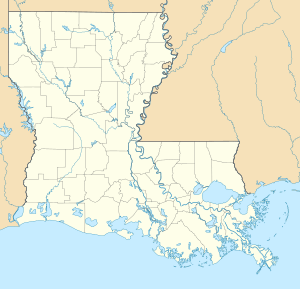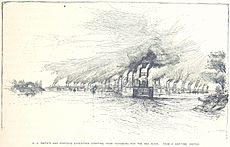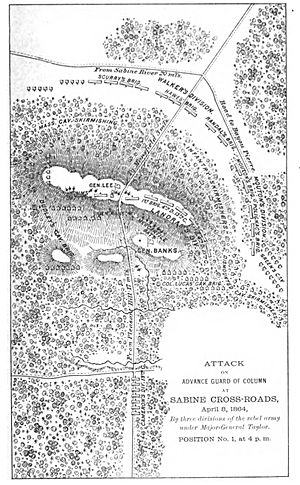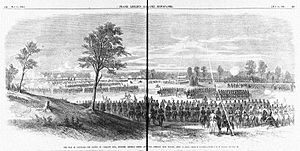Red River campaign facts for kids
Quick facts for kids Red River Campaign |
|
|---|---|
| Part of the Trans-Mississippi Theater of the American Civil War |
|
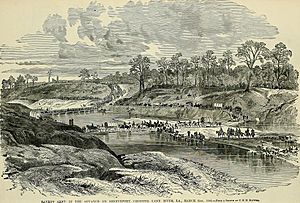
Banks's army crossing the Cane River, March 31, 1864
|
|
| Operational scope | Strategic offensive |
| Location | 32°0′39.28″N 93°39′53.93″W / 32.0109111°N 93.6649806°W |
| Commanded by | |
| Objective | Capture of Shreveport |
| Date | March 10 – May 22, 1864 |
| Executed by | Department of the Gulf |
| Outcome | Confederate victory |
The Red River Campaign was a big military plan by the Union army during the American Civil War. It happened from March to May 1864. The goal was to take control of the Red River area in Louisiana and Arkansas.
The Union wanted to stop the Confederate army from using the important port of Shreveport. They also hoped to get a lot of cotton and sugar from northern Louisiana. This plan was the last major attack the Union tried in this part of the war.
About 30,000 Union soldiers, led by Major-General Nathaniel P. Banks, fought in this campaign. They faced Confederate forces led by General E. Kirby Smith. The Confederate army had between 6,000 and 15,000 soldiers.
The campaign did not go well for the Union. It was poorly planned and managed. The Union army did not achieve any of its main goals. Major-General Dick Taylor successfully defended the Red River Valley with fewer soldiers.
Contents
Why the Union Fought: Goals of the Campaign
The Union army had four main reasons for starting the Red River Campaign:
- To capture Shreveport, which was the state capital and a major Confederate base.
- To defeat the Confederate forces in western Louisiana.
- To take about 100,000 bales of cotton from farms along the Red River.
- To set up new state governments that supported the Union.
Union leaders in Washington thought that controlling eastern Texas and the Red River would separate Texas from the rest of the Confederacy. Texas was a key source of guns, food, and supplies for the Confederate troops.
Some historians also believe the campaign was about showing strength to Napoleon III of France. He had sent 25,000 French troops to Mexico. The Confederates had offered to recognize the French government in Mexico if France recognized the Confederacy. This would have given the Confederates access to important war supplies.
How the Campaign Was Planned
The plan was put together by Major-General Henry W. Halleck. It was ready in January 1864.
General Banks was to lead 20,000 soldiers from New Orleans up to Alexandria. They would meet 15,000 soldiers from Major-General William T. Sherman's army. These extra troops were led by Brigadier-General Andrew J. Smith. Smith's soldiers could only stay with Banks until the end of April. After that, they were needed for other Union battles.
Banks would command this combined force of 35,000 men. Rear-Admiral David Dixon Porter's fleet of gunboats would support them on the Red River. At the same time, 7,000 Union soldiers from Arkansas, led by Major-General Frederick Steele, would march south. They were supposed to meet Banks in Shreveport.
Banks sent a report showing how hard it would be to hold Shreveport without a lot of resources. Many of Banks's men and a large cavalry force marched north. Banks also allowed people who wanted to buy and sell cotton to come along. Admiral Porter brought boats to collect cotton as valuable prizes.
Confederate leaders were not sure where the Union army would attack. But General E. Kirby Smith, who was in charge of the Trans-Mississippi Department, started moving many of his troops to the Shreveport area.
Who Fought: The Armies
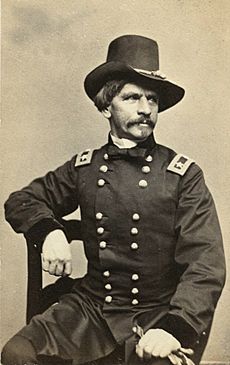

Union Forces
- Major-General Nathaniel P. Banks led the main Union army.
- His army included parts of the 19th, 13th, 16th, and 17th Army Corps.
- Brigadier-General Andrew J. Smith led soldiers from Sherman's army.
- Major-General Frederick Steele led troops from Arkansas.
- Rear-Admiral David D. Porter commanded the Union navy on the river.
Confederate Forces
- General E. Kirby Smith was the overall Confederate commander.
- Major-General Dick Taylor led the main Confederate forces in Louisiana.
- His troops included divisions led by Brigadier-General John G. Walker and Brigadier-General Alfred Mouton.
- Brigadier-General Thomas Green led the Confederate cavalry.
- Brigadier-General Thomas J. Churchill led a group of soldiers from Arkansas.
The Campaign Begins
Major-General William B. Franklin started marching Banks's army from southern Louisiana on March 10. Meanwhile, A. J. Smith's soldiers traveled by boat from Vicksburg. Smith's men surprised and captured Fort de Russy on the Red River on March 14. They captured 317 Confederate soldiers and all their heavy guns. This was the start of the expedition.
Admiral Porter was then able to clear a large raft that was blocking the river. General Taylor had to retreat, leaving Alexandria. This gave the Union forces control of southern and central Louisiana.
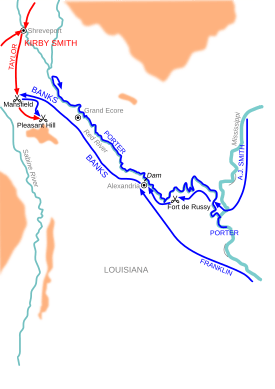
A. J. Smith's army arrived in Alexandria on March 20, 1864. They were supposed to meet Banks's forces there. But Franklin did not arrive until March 25, and Banks arrived on March 26. Banks's delay caused problems and arguments between him and his officers.
While waiting, Smith sent Brigadier-General Joseph A. Mower on a mission. Mower successfully captured many of Taylor's cavalry and an outpost at Henderson's Hill on March 21. Nearly 250 Confederates and four artillery guns were captured without a fight.
When Banks reached Alexandria, he got an important message. Lieutenant-General Ulysses S. Grant had become the new General-in-Chief of the Union Armies. Grant told Banks that Shreveport needed to be taken quickly. He said Smith's troops had to return to Sherman by mid-April, even if it meant giving up the main goal of the expedition.
Kirby Smith had about 80,000 men. But he was not sure where to send them to stop the three Union armies moving toward Shreveport. Taylor never fought with more than 18,500 men during the whole campaign.
By March 31, Banks's men reached Natchitoches, which was 65 miles south of Shreveport. Franklin's men were delayed by rain. Admiral Porter also had trouble getting his largest gunboats over the shallow parts of the river at Alexandria. Taylor was now 25 miles northwest at Pleasant Hill with fewer than 20,000 men. Banks continued his advance a week later.
There were many small fights between the cavalry and naval forces. On April 2, Union cavalry clashed with 1,500 Confederate Texas cavalrymen. These Confederates kept fighting the Union advance. Union officers doubted there would be much Confederate resistance, except from the navy. Banks's army followed Taylor into a thick pine forest, away from the river. As they neared Pleasant Hill, the Union army was spread out too much. Taylor kept moving back toward Shreveport.
Battle of Mansfield
Heavy cavalry fighting continued on April 7. On April 8, Union cavalry charged a small Confederate force near Mansfield, Louisiana. They pushed the Confederates off Honeycutt Hill. Taylor had placed one group of infantry soldiers in the woods near the hill. Seeing more enemy soldiers, the Union cavalry asked for infantry help.
Landram's division of 2,400 men was sent to help. Banks went to the front to see for himself. Taylor brought up a second infantry division. This gave Taylor more soldiers, about 9,000 men, compared to Banks's 5,000. The Union soldiers were also not set up well.
Taylor wanted Banks to attack him. But after an artillery fight, he thought the Union army was disorganized and would not attack. Around 4 p.m., Taylor ordered his men to attack. His soldiers charged across a field and attacked the Union right side. The Union line broke, and many of Landram's men were captured.
A second Union line was set up, but it also broke when faced with Taylor's larger numbers. The Union cavalry's supply wagons blocked the road, so they lost some artillery. However, Confederate soldiers stopped to loot some of the Union wagons. This gave Banks's troops time to retreat.
As the Confederates tried to chase them, they ran into a third Union force. These 5,800 men were on a ridge overlooking Chatman's Bayou. The Confederates pushed forward, but this Union group fought them off. During the night, Banks decided to retreat back to Pleasant Hill. He needed water and wanted to join A. J. Smith's men.
The Battle of Mansfield was over. The Union army lost about 2,400 soldiers. Almost half of these were from Landram's division. The Confederates lost about 1,000 soldiers. General Mouton was killed leading his men.
Battle of Pleasant Hill
Taylor did not know Banks had retreated until the next morning. He ordered his cavalry to chase them. When they found Banks's army near Pleasant Hill, Taylor had his cavalry wait for the infantry. The infantry arrived after noon, having marched 45 miles in 36 hours. Taylor let them rest for two hours before attacking.
At 4 p.m., Confederate infantry started their attack. They thought they were attacking the Union side, but it was actually the center. Confederate cavalry also made mistakes and suffered heavy losses. The Confederates did break the Union center. But this put them in the middle of a U-shaped position, with A. J. Smith's fresh divisions at the bottom of the "U".
Smith and Mower's divisions then launched a counterattack. They drove Taylor's men away from Pleasant Hill. Some cannons were recaptured.
Banks's army was low on water and horse feed. He did not know where his supply boats were. His senior officers also had different ideas. Banks ordered a quick retreat downriver to Natchitoches and Grand Ecore. Both sides at the Battle of Pleasant Hill lost about 1,600 soldiers. It was a small victory for the Union, but a big win for the Confederates. This is because the Union army retreated after the battle.
Splitting of General Taylor's Command
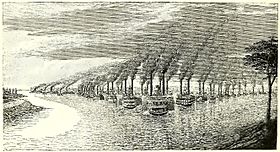
On the river, the Confederates had redirected water into a smaller stream. This made the Red River even lower. When Admiral Porter, who was slowly moving upriver, learned that Banks was retreating, he also turned back. There was a short fight near Blair's Landing on April 12. In this fight, General Green was killed by a naval shell.
At Grand Ecore, Banks received secret orders from Grant. He was told to move his army to New Orleans. The river continued to get lower, and all the supply boats had to go back downriver. Banks's relationships with A. J. Smith and the Navy got worse.
General Kirby Smith decided to take three infantry divisions from Major-General Dick Taylor. He led them north into Arkansas to fight Steele's army. Taylor strongly protested this decision. General Steele never made it to Shreveport because of supply problems and fights with Confederates. The Camden Expedition ended with Steele retreating to Little Rock. Smith left Taylor with one infantry division and the cavalry to keep bothering Banks.
Banks learned that some of Taylor's men had gotten south of him. He also knew the fleet had left for Alexandria. So, Banks ordered a retreat from Grand Ecore. At the Battle of Monett's Ferry on April 23, some of Banks's forces crossed the Cane River. They attacked the Confederate side and forced them to run away. The rest of the march to Alexandria was calm. But Porter ran into an ambush at the mouth of Cane River.
Banks's Retreat
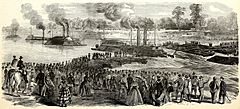
In Alexandria, the arguments between Banks and others got even worse. Each side sent exaggerated stories to newspapers. Major-General John A. McClernand arrived with more soldiers from Texas. He also had bad relationships with A. J. Smith and Porter. Smith only obeyed the orders he wanted to obey.
Porter could not get many of his large ironclad ships over the shallow parts of the river at Alexandria. Colonel Joseph Bailey designed a special dam, called Bailey's Dam. Banks gave a lot of attention to building this dam day and night. Several boats got through before part of the dam broke. An extra dam upriver provided more water depth. This allowed the march to continue.
When the Union soldiers left Alexandria, the town caught fire. No one is sure how the fire started. Many people who came to buy cotton were disappointed because the Confederates had already burned most of it.
Taylor tried to make the Union command think he had more men. But he did not try to stop the dam from being built. He did block the lower river by attacking boats. Even though General Taylor had promised to stop the Union soldiers from escaping, he could not. He blamed Kirby Smith for not helping him enough.
On the way to the Mississippi River, there was a small fight at Mansura on May 16. There were almost no casualties. Yellow Bayou, the last fight of the campaign, happened on May 18. Many soldiers were hurt in a burning forest. Transport ships were tied together to help Union forces cross the wide Atchafalaya River. General Banks met Brigadier-General Edward Canby near the Mississippi. Canby had been named Banks's new superior.
What Happened Next
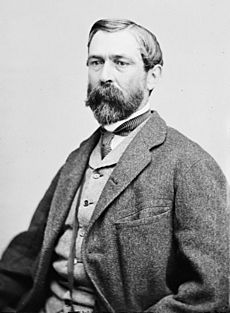
The Red River Campaign was a failure for the Union. It did not have a major impact on the war. In fact, it might have made the war last longer. This is because it took Union efforts away from a more important goal: capturing Mobile, Alabama. Mobile was not captured until 1865. It could have been taken by June 1864 if not for this campaign.
The failure of the campaign ended Banks's military career. Arguments about his retreat and the presence of cotton speculators followed him. Admiral Porter made a lot of money from selling cotton he captured during the expedition.
The Confederates lost two important commanders, Mouton and Green. They also lost soldiers they could not easily replace. More importantly, the relationship between the aggressive Taylor and the cautious Smith was badly damaged. They disagreed strongly about Smith's decision to take half of Taylor's troops after the Battle of Pleasant Hill. Taylor believed Smith had stopped him from capturing the entire Union fleet. This argument led to Taylor being moved to a different command soon after the campaign ended.


